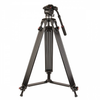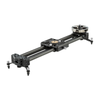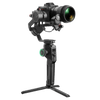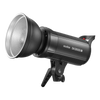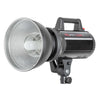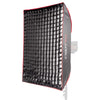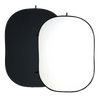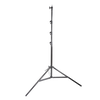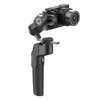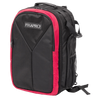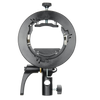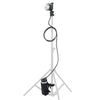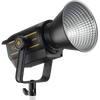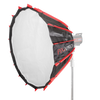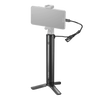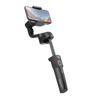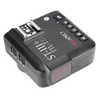Comparing the PiXAPRO Li-ION580II TTL Speedlite with the Li-ION580III TTL (Godox V860II VS Godox V860III)
Speedlites are vital for any photographer shooting on-the-go. Whether you're shooting weddings, indoors or outside, speedlites give you the freedom of movement that a static flash otherwise wouldn't. Today, we're comparing the PiXAPRO Li-ION580II TTL (Godox V860II) and the more recently released PiXAPRO Li-ION580III TTL (Godox V860III) speedlites. If you're wondering whether to upgrade your MKII to the newer MKIII model, here is a rundown of their main differences, and why those changes can be important for your photography.
Similarities
Many aspects of the two models are very similar. For example, both the MKII and the MKIII offer a zoom range of 20-200mm for a wide coverage and a flash range of 1/300 - 1/20,000 secconds in order to produce sharp images. Both models offer a high-speed sync of 1/8000 seconds each with rear curtain sync mode, and they both feature built-in 2.4GHz flash transceivers with 100m ranges on The One System, on which you can mix and match any PIXAPRO range flash. At their cores, they are clearly related, but the MKIII has had many changes that improve the user experience.
See table below for full specification reference.
 |
 |

Left: PiXAPRO Li-ION580II
Right: PiXAPRO Li-ION580III
LED Modelling Light
The primary, and arguably biggest difference between the Li-ION580 MKII and the MKIII is the addition of the built-in LED Modelling Lamp in the MKIII. This feature gives you the option to light the flash for an extended period of time, a feature designed to give you more control over your shots. Constant lighting gives you the opportunity to pre-visualise the shot; to see whether the subject is being lit properly, and to arrange your set and models in the most effective way for the photograph. It can also be used to assist with focusing when shooting at night.
The MKII offered a Depth of Field preview button, which while similar, is a much more limited version. Now, rather than taking test photographs to get the best snap, you can now perfect the result before you start shooting. Features like this make event and wedding photography much more streamlined as it gives you the ability to fine-tune your scene to produce the best possible shots. The modelling lamp also has ten stapes of brightness adjustment, enabling you to control the intensity.

TTL to Manual Switch
An improvement on the MKII, the MKIII also possesses a TTL to Manual switch. While both speedlites feature TTL and Manual shooting, the MKIII has made this process easier. The addition of a switch saves time over changing the settings in the menu and makes the process simple for when you want to change at a moment’s notice!


"Scan for Best Channel" Feature
The Li-ION580 MKIII features a "Scan for Best Channel" feature, which will check through all of the channels available on the Speedlite to see which would be the best to use at that particular time. This helps to reduce any unwanted interferance or connection issue that could occur when manually setting the channel on the Li-ION580 MKII Speedlite.
Hot-Shoe Lock Mounting
Another vital change is the addition of the modern Hot-Shoe Lock Mounting to attach the speedlite to your camera. The updated mechanism offers the MKIII a faster attachment and more security than the MKII, which featured a screw-lock mount.


Quality of Life Improvements
Many of the other differences between the MKII and the MKIII are simple quality of life changes. The MKIII, for example, has a slightly improved battery, running at 2600mAh over the MKII's 2000mAh, which helps the battery to last longer. The MKIII also offers more flexibility, being able to tilt between -7° and 120° on the vertical axis, whereas the MKII could only tilt between -7° and 90°!

New Battery
The Li-ION580 MKIII features a new 11.1V/2600mAh Li-ION Battery to help the Speedlite run better. The benefit for this battery is that it is the exact same battery as used in the GIO1 Speedlite, so if you find yourselves with both of these units, you are free to swap the batteries around without issue.
In essence, while the PiXAPRO Li-ION580II TTL and the PiXAPRO Li-ION580III TTL speedlites may seem very similar to each other, between the modelling light and the new TTL to Manual switch, the newer MKIII model offers many improvements on the older model that help to streamline and ease your photography experience and give you more control over your shots.
Specification |
MKII |
MKIII |
Available For |
Canon, Nikon, Sony, Olympus Panasonic Lumix & Fuji |
Canon, Nikon, Sony, Olympus Panasonic Lumix & Fuji |
Zoom Range |
20-200mm |
20-200mm |
Flash Duration |
1/300 - 1/20,000 sec |
1/300 - 1/20,000 sec |
Exposure Control System |
TTL Autoflash & Manual Flash |
TTL Autoflash & Manual Flash |
Recycle Times |
<1.5 Seconds at Full Power |
<1.5 Seconds at Full Power |
Flash Exposure Compensation (FEC) |
Manual. FEC ± 3 tops in 1/3 stop Increments |
Manual. FEC ± 3 tops in 1/3 stop Increments |
High-Speed Sync |
Up to 1/8000 second |
Up to 1/8000 second |
Rear-Curtain Sync |
Between 1/30 second – 30 Seconds |
Between 1/30 second – 30 Seconds |
Stroboscopic Multi-Flash |
Yes (Up to 100 Flashes, 199Hz) |
Yes (Up to 100 Flashes, 199Hz) |
LED Modelling Light Colour Temperature |
5600K ± 200K |
5300K ± 200K |
Power Source |
7.2V/2000mAh Li-ion battery |
11.1V/2600mAh Li-ion battery |
Full Power Flashes |
Approx. 650 |
Approx. 450 |
Net. Weight |
540g (With Battery) |
530g (With Battery) |
Flash Head Rotation |
0 to 360° Horizontally, -7 to 90° Vertically |
0 to 320° Horizontally, -7 to 120° Vertically |
.jpg)








































